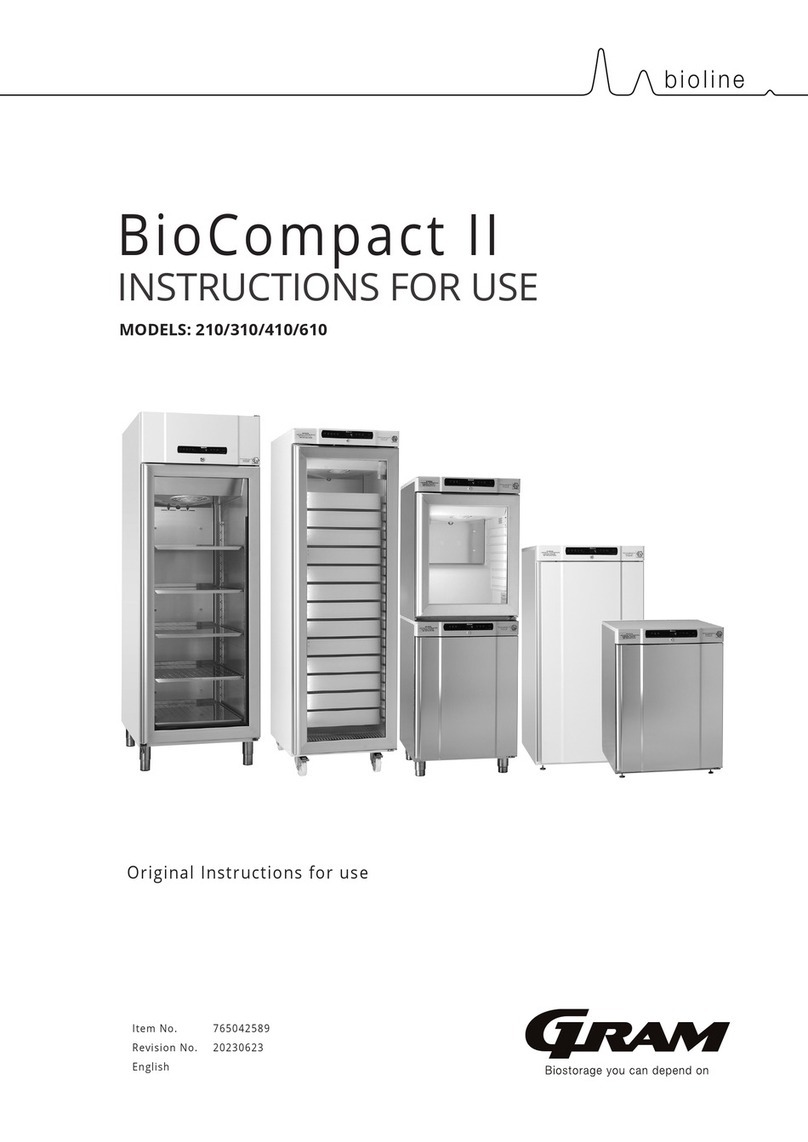
4
b i o l ine
Manufactured by
Gram Commercial
Aage Grams Vej 1 · 6500 Vojens · Denmark
Tel: +45 73 20 13 00
Gram Commercial, lial af Hoshizaki Europe BV, Holland
Table of Content
Copyright © 2006- Gram BioLine, a division of Gram Commercial,
Denmark. All rights reserved.
The content of this publication is owned by Gram BioLine, unless
otherwise noted, and is protected by Danish and international copyright
laws and provisions. Information and images may not be used, copied or
transferred without the express written permission of Gram BioLine.
Quick guide – BioCompact II ..............................2
Table of Content ........................................4
Before you proceed . . . . . . . . . . . . . . . . . . . . . . . . . . . . . . . . . . . . . . 5
Cabinet components.....................................6
BioCompact II 210, 310, 410, 210/210, 310/210...............6
BioCompact II 610 .......................................8
Installation ............................................10
Initial setup steps .......................................10
Anti tilt bracket .........................................12
Surroundings ..........................................14
Voltage-free contact.....................................16
Connection to power ....................................18
Equipotential bonding ...................................20
Start-up ...............................................23
The digital display.......................................23
Walkthrough of menu ...................................24
Error codes ............................................25
Local alarm settings ....................................26
Local high alarm .......................................26
Local low alarm.........................................26
Local alarm settings .....................................27
On/O local door alarm .................................28
Delay for local door alarm................................28
Local acoustic settings ...................................29
External alarm settings .................................30
External high alarm .....................................30
External low alarm ......................................30
External high alarm delay ................................31
External low alarm delay .................................31
On/O external door ...................................32
External
door alarm delay alarm ..........................32
External acoustic settings ................................33
Parameter settings .....................................34
Sensor oset ...........................................34
Escorted/set alarm limits.................................36
Defrosts/24 hours ......................................37
Display sensor..........................................38
Electric low temperature protection .......................39
Ordinary use...........................................40
Regular maintenance ..................................42
Cleaning ...............................................42
Door gasket ............................................43
General info ...........................................44
Service ................................................44
Type/number plate. . . . . . . . . . . . . . . . . . . . . . . . . . . . . . . . . . . . . . 44
Defrost water ..........................................45
Access port ............................................46
Important..............................................47
Disposal ...............................................48
GMP Documentation ...................................49
IQ, OQ & PQ............................................49
Datasheet .............................................50
BioCompact II 210, 310, 410, 210/210, 310/210 ................50
BioCompact II RR210H...................................51
BioCompact II RR310H...................................52
BioCompact II RR410H...................................53
BioCompact II RF210H ..................................54
BioCompact II RF310H ...................................54
BioCompact II RF410H ...................................55
BioCompact II RR210/RR210H ............................56
BioCompact II RR210/RF210H.............................57
BioCompact II RF210/RF210H.............................58
BioCompact II RR310/RF210H.............................59
BioCompact II RR210G...................................60
BioCompact II RR310G...................................61
BioCompact II RR410G...................................62
BioCompact II RF210G ..................................63
BioCompact II RF310G ...................................63
BioCompact II RF410G ...................................64
BioCompact II RR210/RR210G ............................65
BioCompact II RR210/RF210G.............................66
BioCompact II RF210/RF210G.............................67
BioCompact II RR310/RF210G.............................68
BioCompact II RR610H...................................70
BioCompact II RF610H ...................................71
BioCompact II RR610G...................................73
BioCompact II RF610G ...................................74
Declaration of conformity ..............................76
Wiring diagram ........................................80
BioCompact II RR210/310/410 ............................80
BioCompact II RR610 – with solid door .....................81
BioCompact II RF610 – with solid door .....................82
BioCompact II RR610 – with glass door.....................83
BioCompact II RR610 – with solid door, with LTP ............84
BioCompact II RR610 – with glass door, with LTP ............85
Piping diagram ........................................86




























